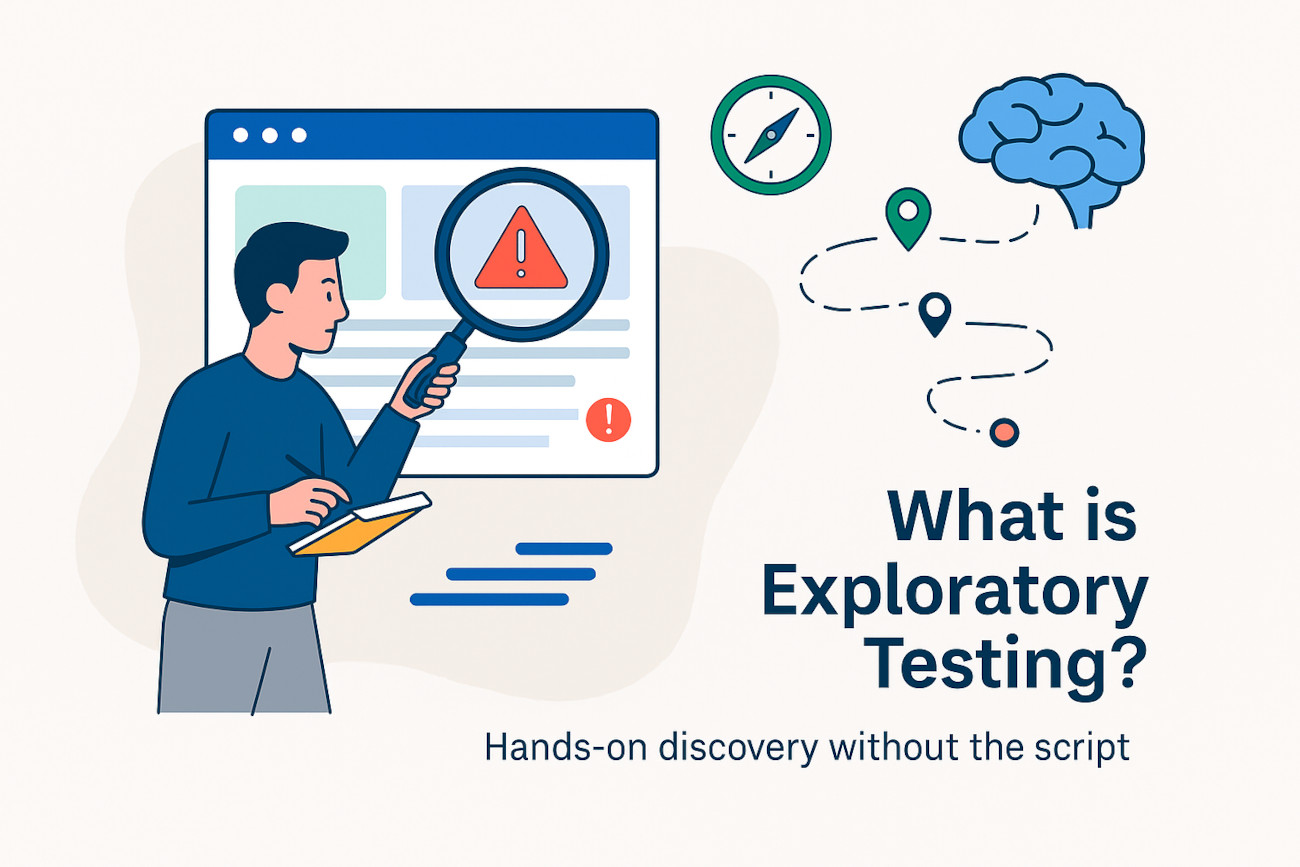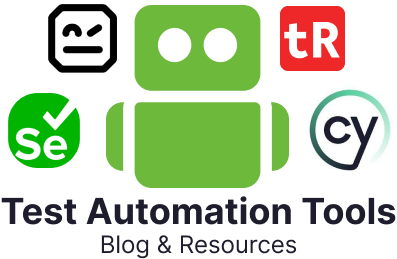
In the existing accelerated software development world, where continuous integration and Agile practices are the rule, testers need techniques that can keep up with delivery speed without compromising product quality. One such practice that highlights simultaneous learning, test design, and execution is exploratory testing. Exploratory testing, as compared to traditional scripted testing, relies on a tester’s expertise, creativity, and intuition to quickly determine critical bugs and usability issues.
This blog explores the definition of exploratory testing in software testing, its benefits, methods, compatibility with Agile environments, and the different reasons why it has slowly gained traction with modern QA teams.
Exploratory Testing Definition
Software testing that includes tandem test design and execution is known as exploratory testing. Testers actively analyze the application, ask questions, come up with hypotheses, and validate these concepts in real time rather than sticking to prewritten test scripts. It calls for critical thinking, intuition, and familiarity with the application and domain under test.
The term “exploratory testing” was first coined by Cem Kaner in the 1980s and has since transformed into a well-known practice in Agile and DevOps teams. It offers a flexible and dynamic method of identifying bugs, especially those that automated or scripted tests might ignore.
Key Features of Exploratory Testing
- Simultaneous Design and Execution: Exploratory testing does not separate test design, execution, and analysis into separate phases. The tester generates test concepts on the spot and executes them right away while they explore the application. This simultaneous process encourages rapid feedback and innovation.
- Cognitive Engagement: Exploratory testing needs continuous mental efforts. Real-time observation, interpretation, hypothesis and response are needed of testers. With this level of involvement, testers are able to detect minor problems that automated tools or scripted tests might overlook.
- Minimal Documentation: Exploratory testing often utilizes lightweight artifacts such as session notes, test charters, or mind maps in place of extensive pre-written test cases. These help in session guidance without burdening the tester with extensive paperwork.
- Flexibility and Adaptability: Testers are free to modify their plans in response to findings because they are not required to stick to a rigid script. Without having to wait for the formal review or updating of the test plan, testers can dive deeper immediately if the test reveals unplanned behavior.
- Experience-Driven Testing: This method utilizes experienced testers’ domain skills and intuition. Their knowledge of comparable systems, common failure modes, and edge cases greatly boosts the testing process’s quality.
- Learning-Oriented: Testers are constantly learning about the system, its risks, and its use cases. The process is highly adaptive and self-improving since every new interaction informs the next.
Benefits of Exploratory Testing
Rapid Discovery of Critical Defects
Early in the development cycle, exploratory testing is ideal for detecting complex and critical flaws. Testers can take unexpected routes and identify hidden or emerging issues that might be ignored in scripted testing because they are restricted by predefined cases.
Better Coverage of Tests
Exploratory testing, in spite of its clear lack of structure, often results in more extensive test coverage. In order to conduct thorough testing across different application areas, testers naturally navigate through functionalities, edge cases, and odd usage patterns that users might actually follow.
Economical and Effective
Exploratory testing helps QA teams to focus more on actual testing by cutting down the amount of time needed to be invested on test case documentation and upfront planning. Faster turnaround times can be achieved with this practice, specially in continuous and Agile delivery environments where efficiency is a must.
Increase the Motivation of Testers
Testers often find exploratory testing to be more fulfilling and interesting because it places a greater emphasis on independence, innovation, and problem-solving. Improved team morale, more insightful testing, and better focus are all achieved with this increased motivation.
Better Collaboration with DevOps and Agile
The rapid, iterative nature of Agile and DevOps processes is supported by exploratory testing. It makes it possible for immediate feedback, consistent education, and quick adjustment to changing needs. By addressing scenarios that automated testing might miss, it also improves automated testing.
Adaptable to Change
Exploratory testing helps QA teams to test new functionalities or bug fixes in quickly evolving projects without having to wait for holistic test scripts. When requirements are unclear or have the potential to change as development progresses, this flexibility is vital.
Encourages UX and Usability Testing
Examining the user experience is an expected feature of exploratory testing. It is simpler to detect UX inconsistencies, navigation issues, or confusing workflows when testers interact with the product in a manner that mimics the real-time user interaction.
Exploratory Testing v/s Scripted Testing
| Feature | Exploratory Testing | Scripted Testing |
|---|---|---|
| Test Design | On-the-fly | Predefined |
| Reproducibility | Moderate | High |
| Documentation | Light | Extensive |
| Tester Involvement | High | Medium |
| Adaptability | High | Low |
For regression testing, scripted testing is reliable because it adheres to an expansive plan. It does not, though, provide the same flexibility and cognitive engagement as exploratory testing.
Methods used in Exploratory Testing
Exploratory testing based on sessions (SBTM)
This method utilizes time-boxed sessions to provide exploratory testing with a structure. A charter defining a specific mission or goal, such as “Explore shopping cart functionality for usability issues,” behaves as the guide for each session. Testers record their findings, actions, and any questions that they might have. Every session ends with a discussion to encourage improvement and knowledge transfer.
Freestyle testing
Maximum freedom is achieved with freestyle exploratory testing. Without a set structure or scope, testers are able to navigate the system using their knowledge and intuition. Since it encourages unbiased discovery, this is often where young testers or those examining new systems should begin with.
Scenario-Based Testing
In scenario-based testing, testers develop use case scenarios or user stories and investigate the system from the POV of the user. This method is especially helpful for UX and functional validations since it aids in identification of issues that affect usability and user flows in the real world.
Exploratory Pair Testing
In a single session, two testers or a tester and a developer collaborate. While one person conducts the session by interacting with the system, the other takes notes, monitors behavior, and provides varied test ideas. This cooperative method increases perspective and encourages test creativity.
Risk-Based Exploratory Testing
Areas of the application that are most likely to crash or have major business impact are given higher priority while using this method. Testers spent more time exploring features that are more complex, recently developed, or have previously posed problems. This ensures that testing resources are efficiently used.
Tour-Based Testing
Tour-based testing, which is built on James Whittaker’s methodology, breaks down exploration into thematic tours. For instance, a “Data Tour” might verify test input fields and data handling, while a “Link Tour” may validate links and navigation. These help testers methodically assess different aspects of the system.
Heuristic-Based Testing
To identify which areas are worth testing, testers leverage mental shortcuts or general guidelines, such as the SFDPO model (Structure, Function, Data, Platform, Operation). When limited time is available, heuristics offer a flexible yet targeted method of guiding exploratory sessions.
How Exploratory Testing is Implemented
- Define a Charter: The session’s mission statement should be something like “Explore the login feature for security loopholes.”
- Time-Box the Session: Usually, sessions run between sixty and ninety minutes.
- Explore and Record Observations: Make notes and, if needed, record your screen.
- Debrief and Analyze: Share findings, reflect on learnings, and identify the next actions.
When to Use Exploratory Testing?
- In the early phases of development, when specifications are still evolving.
- During Agile sprints, when immediate feedback is vital.
- To find edge cases and implement usability testing.
- When assessing major modifications or new functionalities.
- To validate the fixes for previous flaws.
Exploratory Testing in Agile and DevOps
By providing quick insights without needing the creation of scripted test cases, exploratory testing optimizes Agile testing strategies. Teams benefit from its ability to:
- Adapt to rapidly evolving requirements.
- While testing, conduct continuous learning.
- Shorten feedback loops.
- Increased collaboration between QA, developers, and product owners.
To ensure deep defect discovery and expanded coverage, DevOps teams often combine exploratory testing with automation.
Common Myths about Exploratory Testing
- It is only Ad-hoc testing: Exploratory testing is more structured, especially when using SBTM, even though both methods are unscripted.
- It can’t be measured: Charters, identified bugs, session length, and coverage area; everything can be tracked.
- It doesn’t need tools: Exploratory sessions are routinely improved by using tools such as bug trackers, mind maps, and recording tools.
Conclusion
Exploratory testing is a powerful addition to scripted or automated testing, and not just a replacement. It aids testers to build and run tests in real time, which reveals hidden problems, encourages creativity, and is best for Agile and DevOps methodologies.
Organizations that want to achieve faster delivery cycles and high software quality should consider making exploratory testing a central step of their QA strategy. When implemented correctly, it converts testing from a mechanical process to an imaginative, inquisitive, and highly insightful step.
